You walk into a coffee shop and want to start your day with a grande Cappuccino. The barista starts making your coffee, and you’re sitting at your table, staring at the birds chirping outside the window.
You reach out to your pocket and suddenly realize that you forgot your wallet at home. You look around and stumble upon a sign that says, “Cryptocurrency accepted,’’ which brings a sigh of relief because you have a phone with an ethereum wallet.
Your coffee is now ready, and the barista calls your name. You collect your freshly brewed grande Cappuccino and take out your phone to scan the QR code at the counter to pay for the coffee in ethereum.
Suddenly, you notice that the coffee shop only accepts “bitcoins’’ and you can’t pay in ethereum. You still want to try your luck, so you scan the QR code, but it all ends with an embarrassment.
That’s a major problem in the blockchain ecosystem today, and we call it “lack of interoperability’’!
What is interoperability?
Interoperability simply means “cross-communication,’’ where two or more completely different systems can talk to each other and exchange value. In the traditional financial system, the majority of payments infrastructure is interoperable.
You can simply swipe your debit or credit card and pay for goods and services regardless of what currency the store accepts. If you’re traveling abroad with a card issued by your bank, you know it is accepted everywhere regardless of what the local currency is — that’s interoperability.
In the blockchain space, interoperability is when two more blockchain systems can talk to each other and exchange value. Coming back to the coffee shop experience, you should be able to pay with ethereum even though the store accepts bitcoin and that too in a decentralized environment. Still, unfortunately, that’s not the case.

Just like with the internet, you have a web service that provides an API through which you can talk to that specific web service. That API acts as a communication layer between the web service and all other external services on the web. Unfortunately, we don’t have such cross-chain communication protocols developed for blockchain, so they work and exist in silos.
In a moment, you will see that this space is evolving, and many protocols work similarly, as shown in the diagram above. But first, let’s discuss some of the solutions that existed in the past, which laid the foundations for the platforms that we have today for the cross-chain communication and interoperability.
#defi #blockchain #cross-chain #interoperability-in-blockchain #cryptocurrency #decentralized-finance #blockchain-top-story #hackernoon-top-story
